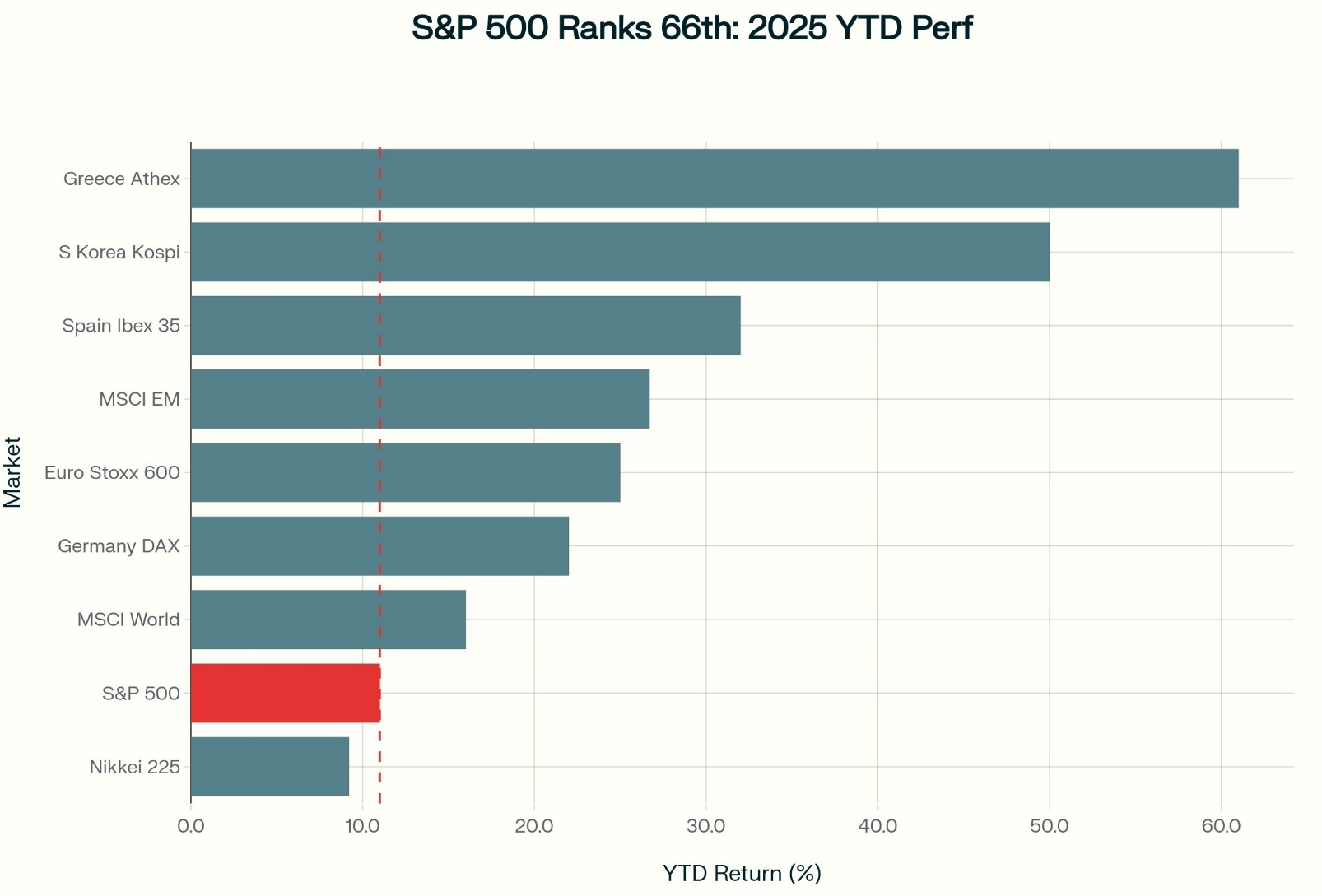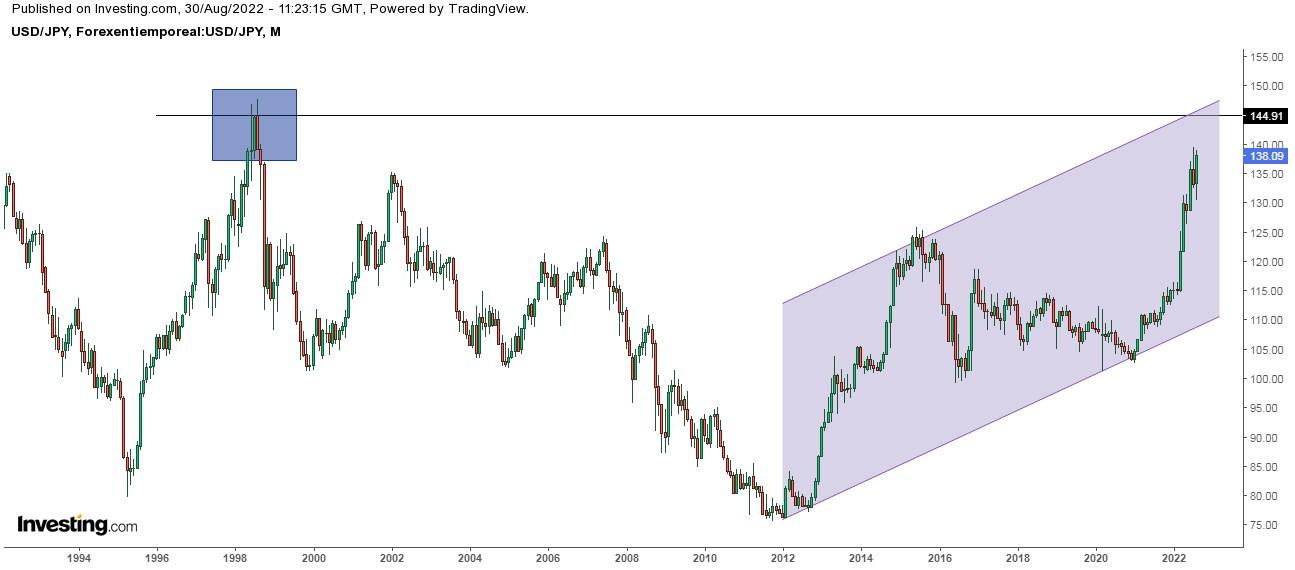The International Monetary Fund issued a warning this Tuesday that investors have grown “too complacent” about rising risks, even as asset prices trade “well above fundamentals.” The global lender said conditions now exist for a potential “sudden, sharp correction.”
The warning, delivered in the IMF’s semiannual Global Financial Stability Report, comes as US stocks hover near record highs despite ranking just 66th among global equity indices year-to-date. The S&P 500 has gained 11% in 2025, trailing Germany’s (+22%), South Korea’s Kospi (+50%), and emerging markets broadly (+26.7%).
Markets reacted Tuesday morning. The fell 321 points, while the S&P 500 dropped 0.85% as US-China trade tensions added to concerns about stretched valuations and concentration risk in mega-cap technology stocks.

Global stock market performance in 2025 shows the S&P 500 trailing most major indices despite record highs
Concentration Risk at Historic Levels
The IMF focused particular concern on the so-called Magnificent Seven stocks, , , , , , , and , which now account for 33% of the S&P 500’s total market capitalization. This concentration creates systemic vulnerability, as disappointing results from just a handful of companies could trigger broader market weakness.
“Beneath the calm surface, the ground is shifting in several parts of the financial system, giving rise to vulnerabilities,” the IMF stated. Unlike the dot-com bubble, where speculation spread across hundreds of technology stocks, today’s rally is “driven by a narrow group of stocks spanning mega-cap IT and AI-related firms.”
Analyst expectations for profit margins have been revised downward across most sectors, with one exception: the Magnificent Seven. If these companies fail to deliver the outsized earnings growth justifying their valuations, correction risk increases.
Valuation Gap Between US and Global Markets
At 22 times forward earnings, US equities trade at a 46% premium to global peers. The IMF’s models suggest this gap lacks fundamental justification. European equities trade at a 35% discount despite improving fundamentals and stronger-than-expected earnings growth.
“The high valuations in US equities are a reflection of the complacency shown by investors in the face of big changes to the global trade system,” the IMF noted. US stocks have underperformed most developed and emerging markets this year.
The dollar’s 10% decline year-to-date (its worst first-half performance since 1973) has eroded returns for unhedged foreign investors. After currency effects, the S&P 500’s 11% gain translates to roughly 1% for international holders.

US stocks trade at a 46% valuation premium to global peers while delivering significantly lower returns in 2025
Trade Tensions Rise Alongside IMF Warning
Tuesday’s market weakness followed President Trump’s threat of an additional 100% tariff on Chinese goods, after Beijing tightened rare earth export controls. China responded with new port charges on US vessels and additional tariffs on products ranging from timber to kitchen cabinets.
The IMF’s growth projections already factor in some tariff impact, with global GDP expected to slow from 3.3% in 2024 to 3.2% in 2025 and 3.1% in 2026. A full-blown trade war exceeding current assumptions could trigger the market correction the Fund warns about.
“Markets are too comfortable with risks,” said Tobias Adrian, director of the IMF’s Monetary and Capital Markets Department. “These vulnerabilities may not act in isolation. They could amplify one another.”
Fiscal Concerns Grow
The IMF flagged deteriorating fiscal conditions in major economies. The US federal deficit reached $1.8 trillion in fiscal 2025 (6.2% of GDP) a level historically associated with deep recessions rather than economic expansion. Net interest on the national debt now exceeds $1 trillion annually.
The Fund called for “urgent fiscal adjustments” to preserve bond market stability, warning that current trajectories risk “broad and disruptive ramifications.” With the US government in its second week of shutdown and limited political appetite for fiscal restraint, policymakers appear unconcerned.
Safe-Haven Flows Show Changing Sentiment
’s 53% rally to above $4,000 per ounce reflects growing policy uncertainty and reduced confidence in dollar-denominated assets. The precious metal has outperformed every major asset class in 2025, with safe-haven demand rising even as equity markets reach new highs.
The gap between gold’s strength and the dollar’s weakness shows how global investors view US financial stability and policy credibility differently than in past years.
Key Levels and Catalysts Ahead
The S&P 500 recently broke below its 50-day moving average, a technical signal that could attract selling if it holds. Key support lies at 6,850, with resistance at the recent high of 7,100.
Upcoming catalysts include November’s scheduled tariff implementations, third-quarter earnings reports from the Magnificent Seven, and Federal Reserve commentary on inflation and growth risks. Disappointment on earnings or escalation in trade tensions could test the market.
Investment Implications
The IMF’s assessment suggests the risk-reward profile for US mega-cap technology stocks has changed. For investors with concentrated US equity exposure (typical American portfolios maintain 70%+ domestic allocation) diversification deserves attention.
International markets offer better valuations, with European equities trading at 35% discounts and benefiting from interest rates roughly half US levels. Emerging markets show faster earnings growth from lower bases, with exposure to global economic expansion less dependent on a handful of technology giants.
The IMF isn’t forecasting a crash. But the margin for error has narrowed. With valuations stretched, concentration risk high, trade tensions rising, and fiscal trajectories unsustainable, investor complacency looks out of place.
As markets process these warnings, the question is whether portfolios are positioned for the correction the IMF sees as more probable.